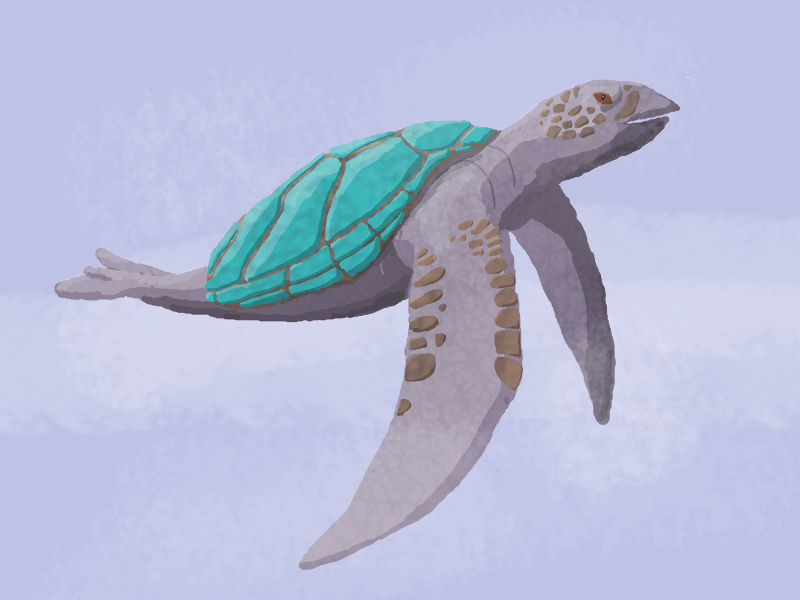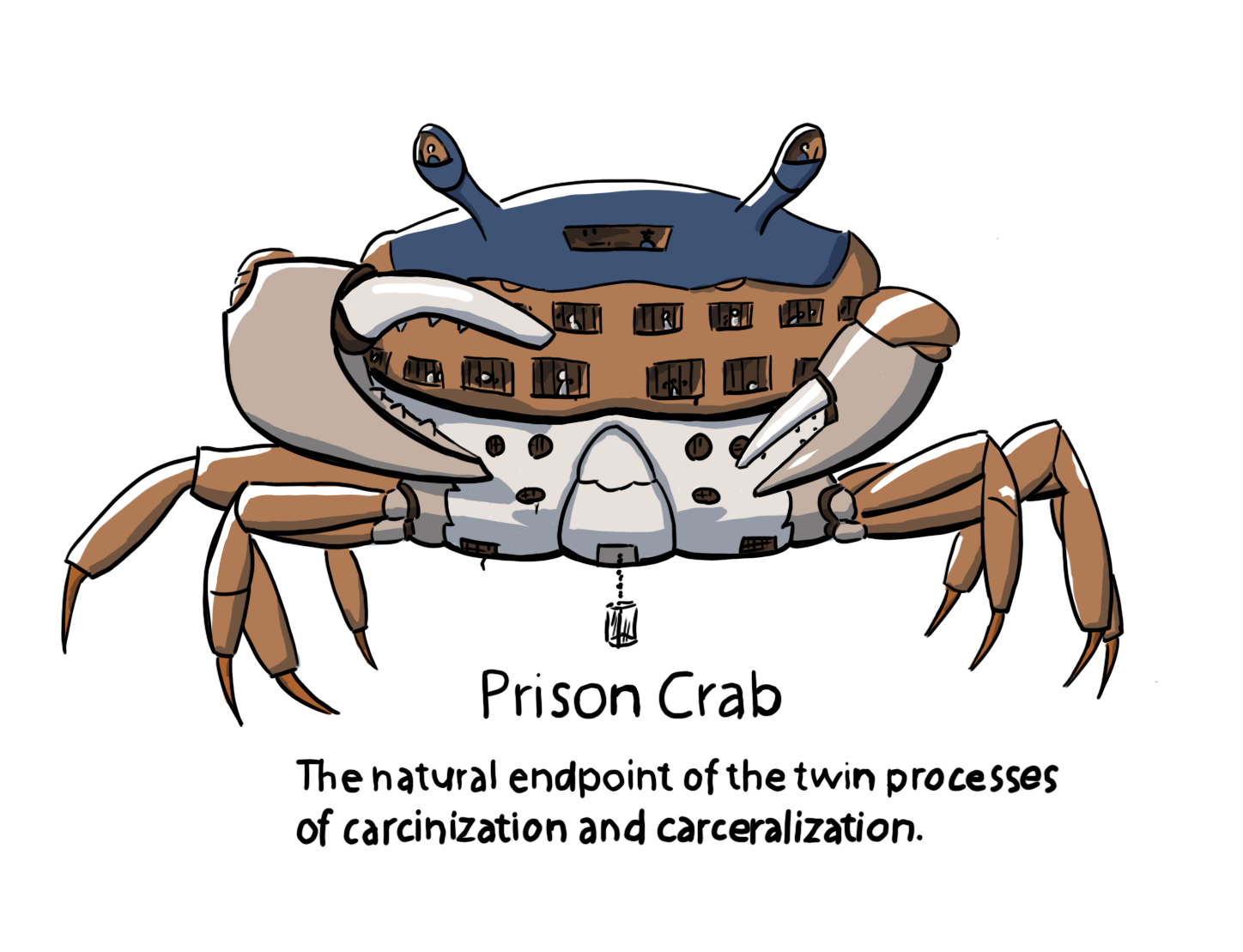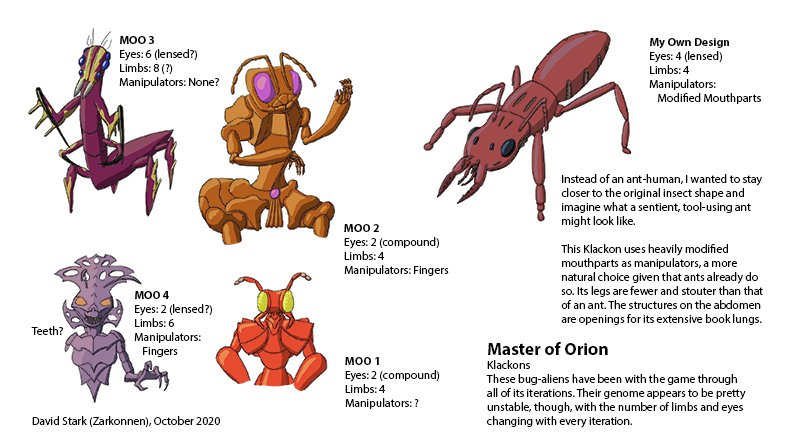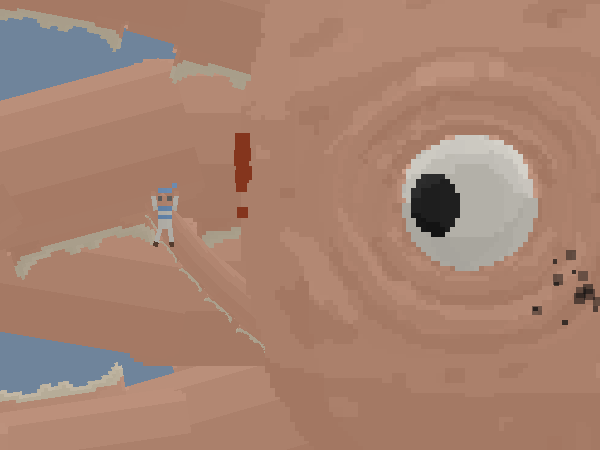David Stark / Zarkonnen: creatures
- Prison Crab!
More doodles.
- Klackons
I've just acquired a new graphics tablet, since my old one died after nearly two decades of service. I'm using it as an opportunity to finally do regular drawing practice. Here, I've drawn the Klackons from the Master of Orion series in all their incarnations, plus my own take on them.
- By the Nailsea
"It's not you, it's me!" she whispered, urgently. I dropped to my knees and put my ear to her chest. She was right. The buzzing was coming from her heart, not mine, and it was stronger than I had thought. Not much time left.
- The Kraken
After a series of bug fix releases for dev 8, I am now making headway on dev 9 and its menagerie of monsters. In a previous post, I showed you the tentacle movement I implemented for the game. Now I want to show you how these tentacles are actually used by the Sky Kraken.
- Alien idea: The queen is the hive
Ant colonies consist of a number of highly specialized creatures: Sterile females function as workers and warriors. Males only live for a short time and basically amount to a girl-seeking vector for genetic material. And each nest usually has only one fertile female, the queen, who never leaves her chamber and churns out eggs. (There's an exception to this, but I don't want to get into the whole gamergate thing right now.)
So in a classic science fiction approach, let's take a real creature and turn things up to eleven.
- Overlays and Aerial Krakens
Now that the weather here in Zurich is no longer boiling-hot, I've started streaming game development again. In the first stream, which you can watch below if you like, I worked on info overlays for the ship editor.
- Better Explosions
In between major releases of Airships, I like to work on things that don't require deep changes to the game's code but make the whole experience better. For version 7.2, I want to make the combat feel more visceral, which of course mainly means one thing: better explosions.
- Alien idea: Co-domestication complexes
A common question in science fiction is what humans are like relative to other sentient life-forms. Because we only know life from one planet, Earth, we have insufficient reference points to know how we might compare.
Perhaps the most popular trope that answers this is "humans are average" - we're medium-sized, medium-smart, medium-aggressive, medium-everything. This sometimes gets extended into "humans are flexible", a kind of earthling boosterism wherein we come out on top exactly because we're more well-balanced than the aliens.
- Additionally abstracted aliens
I really like to come up with interesting aliens - both sentient ones as well as weird alien ecosystems. One idea that occurred to me a while ago is a planet where all macroscopic animal life is technically the same species.
- NeoCats
It's the future. Humanity flies amongst the stars, part of a galactic society of thousands of sentient species. We're not special in any way. We're not important. We're not very well-known, and we sort of like it that way. Because if we're known for anything, it's for the damnable galactic plague that is cats.
- Concepts and Videos

- On Suspendium
Suspendium crystals are what keep the airships aloft. How do they work? I mean, obviously they're fictional, but it's nice to have consistent rules in your fiction. As you'll see, thinking about the rules of Suspendium leads to a whole bunch of worldbuilding as a consequence.
- Labyrinth Lord: Axolotl Men
Following a discussion playing Labyrinth Lord a while ago, here's a quick proposed "Axolotl man" class:
- Axolotls are awesome

Axolotls are essentially salamanders that have refused to grow up. Salamanders, being amphibians, start their life as aquatic larvae, but eventually metamorphose into at least partially land-dwelling lizard-like animals. Axolotls are the exception, spending their whole life in their larval form, becoming sexually mature without metamorphosing.
- Internal consistency and dragons
This is another installment of "how I would do fantasy creature X". This time: dragons.
- A silly idea about werewolvesWerewolves are very much a common trope in fantasy, and one infused with all kinds of cultural and sexual baggage that I can't be bothered to unpack right now. Instead, I'm going to present you with another bit of horrible worldbuilding, suited for any kind of schlocky fantasy setting.
- Fictional reproductive biologyThe biology of reproduction is really cool and weird. With some sharks, the offspring devour one another in the womb. With some reptiles, the sex of the offspring is determined by the temperature of the egg. Clownfish change sex depending on hierarchy: the dominant fish is female. As a whole, there's lots of truly weird stuff, and it's really fun to speculate about paths not taken.
- The Frogfish
One of my hobbies is spending too much time on Wikipedia reading about the odd branches of the tree of life, and collecting unusual biology facts. It's occurred to me that I should write them up for your edification. Here's the first one: the frogfish.



